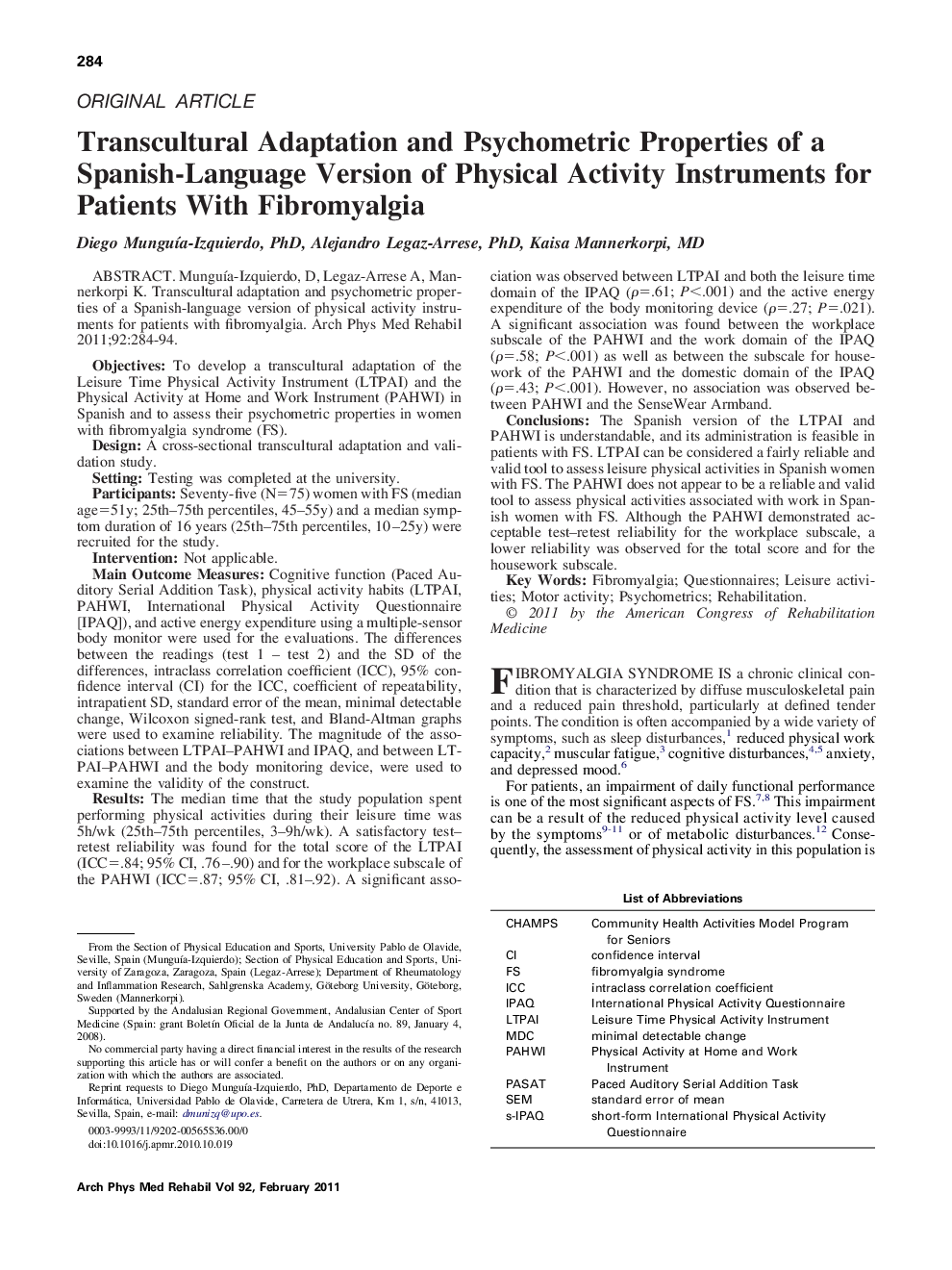| Article ID | Journal | Published Year | Pages | File Type |
|---|---|---|---|---|
| 3450489 | Archives of Physical Medicine and Rehabilitation | 2011 | 11 Pages |
Munguía-Izquierdo, D, Legaz-Arrese A, Mannerkorpi K. Transcultural adaptation and psychometric properties of a Spanish-language version of physical activity instruments for patients with fibromyalgia.ObjectivesTo develop a transcultural adaptation of the Leisure Time Physical Activity Instrument (LTPAI) and the Physical Activity at Home and Work Instrument (PAHWI) in Spanish and to assess their psychometric properties in women with fibromyalgia syndrome (FS).DesignA cross-sectional transcultural adaptation and validation study.SettingTesting was completed at the university.ParticipantsSeventy-five (N=75) women with FS (median age=51y; 25th–75th percentiles, 45–55y) and a median symptom duration of 16 years (25th–75th percentiles, 10–25y) were recruited for the study.InterventionNot applicable.Main Outcome MeasuresCognitive function (Paced Auditory Serial Addition Task), physical activity habits (LTPAI, PAHWI, International Physical Activity Questionnaire [IPAQ]), and active energy expenditure using a multiple-sensor body monitor were used for the evaluations. The differences between the readings (test 1 – test 2) and the SD of the differences, intraclass correlation coefficient (ICC), 95% confidence interval (CI) for the ICC, coefficient of repeatability, intrapatient SD, standard error of the mean, minimal detectable change, Wilcoxon signed-rank test, and Bland-Altman graphs were used to examine reliability. The magnitude of the associations between LTPAI–PAHWI and IPAQ, and between LTPAI–PAHWI and the body monitoring device, were used to examine the validity of the construct.ResultsThe median time that the study population spent performing physical activities during their leisure time was 5h/wk (25th–75th percentiles, 3–9h/wk). A satisfactory test–retest reliability was found for the total score of the LTPAI (ICC=.84; 95% CI, .76–.90) and for the workplace subscale of the PAHWI (ICC=.87; 95% CI, .81–.92). A significant association was observed between LTPAI and both the leisure time domain of the IPAQ (ρ=.61; P<.001) and the active energy expenditure of the body monitoring device (ρ=.27; P=.021). A significant association was found between the workplace subscale of the PAHWI and the work domain of the IPAQ (ρ=.58; P<.001) as well as between the subscale for housework of the PAHWI and the domestic domain of the IPAQ (ρ=.43; P<.001). However, no association was observed between PAHWI and the SenseWear Armband.ConclusionsThe Spanish version of the LTPAI and PAHWI is understandable, and its administration is feasible in patients with FS. LTPAI can be considered a fairly reliable and valid tool to assess leisure physical activities in Spanish women with FS. The PAHWI does not appear to be a reliable and valid tool to assess physical activities associated with work in Spanish women with FS. Although the PAHWI demonstrated acceptable test–retest reliability for the workplace subscale, a lower reliability was observed for the total score and for the housework subscale.
